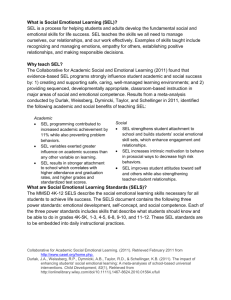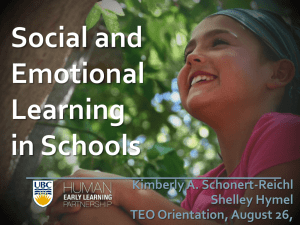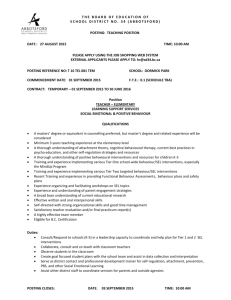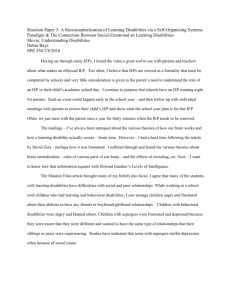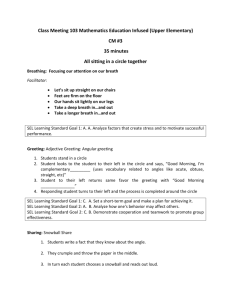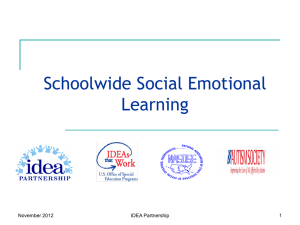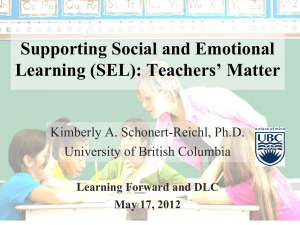Social Emotional Learning Curriculum and Student Achievement
advertisement
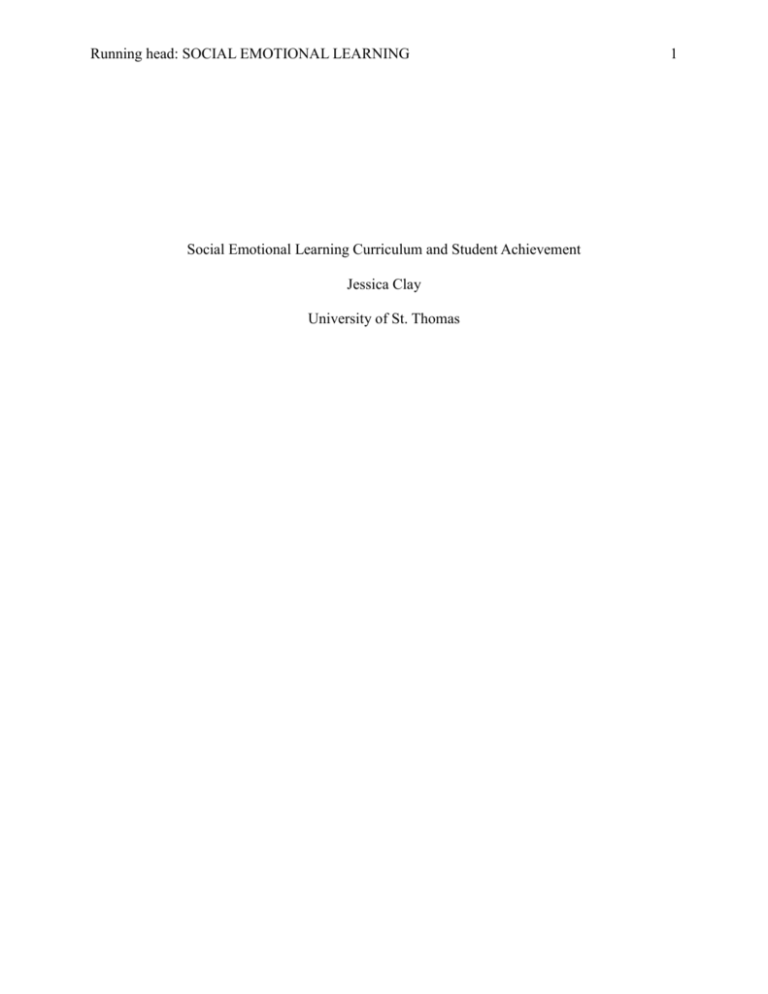
Running head: SOCIAL EMOTIONAL LEARNING Social Emotional Learning Curriculum and Student Achievement Jessica Clay University of St. Thomas 1 SOCIAL EMOTIONAL LEARNING 2 Research Question: Can social and emotional learning standards improve academic performance? Expository Through a review of recent literature, one can adequately define social and emotional learning (SEL) in terms of impact on academic achievement. An opportunity exists for schools to further incorporate tenets of SEL so that teachers and students alike can benefit from school climates that meet both academic and social emotional needs. Louis Cozolino’s (2013)recently published book, The Social Neuroscience of Education: Optimizing Attachment and Learning in the Classroom, asserts that “education is an art built upon the social relationship between teacher and student that harnesses the neural mechanisms of learning” (p. ). Cozolino’s (2013) neuroscientific explanation of learning recognizes that students’ “ability to learn is regulated by how we are treated by our teachers, at home and in the classroom” (p. ). His thesis aligns with other current findings in the field of SEL research. The Collaborative for Social and Emotional Learning, (CASEL), is a SEL advocacy group. “The Missing Piece: A National Teacher Survey on how Social and Emotional Learning Can Empower Children and Transform Schools” defines SEL as “processes through which adults and children develop social and emotional competencies” in self awareness, self management, social awareness, relationship skills, and responsible decision making (Civic Enterprises, Bridgeland, Bruce & Hariharan, , 2013, p. ). The CASEL study finds that in terms of academic achievement, “Eight in ten teachers think that SEL will have a major benefit on students’ ability to stay on track and graduate and will increase standardized test scores and overall academic performance (77%). Three quarters (75%) believe SEL will improve student academic achievement” (Civic Enterprises et al., 2013, p. ). Civic Enterprises et al. (2013) and SOCIAL EMOTIONAL LEARNING 3 Cozolino (2013) both show that SEL and academic achievement are part and parcel to each other. Furthermore, a meta-analysis shows that schools where students participate in SEL score 11 percentile points higher than students who do not receive SEL instruction (Durlak, Weissberg, Dymnicki, Taylor, & Schellinger, 2011). These research findings can help to further define SEL as an integral part of any academic program. The meta-analysis authors also contend that, “students typically do not learn alone, but rather in collaboration with their teachers, in the company of their peers, and with the en-couragement of their families. Emotions can facilitate or impede children’s academic engagement, work ethic, commitment, and ultimate school success (Durlak et al., 2011). The Educator’s Guide to Emotional Intelligence and Academic Achievement, note that SEL is sometimes called “…character education, service learning, citizenship education, and emotional intelligence” (Elias & Arnold, 2006, p. ). SEL is further defined as “…a way of teaching and organizing classrooms and schools that helps children learn a set of skills needed to successfully manage life tasks such as learning, forming relationships, communicating effectively, being sensitive to others’ needs, and getting along with others” (Elias & Arnold, 2006, p. ). SEL is about creating a “caring climate” for educators and students alike (Elias & Arnold, 2006). Based upon the literature ranging from neuroscience, to psychology, meta-analysis, and surveys, it is clear that social emotional learning can be defined as a necessary foundation for academic learning Civic Enterprises et al., , 2013; Cozolino, 2013; Elias & Arnold, 2006). SEL encompasses competencies that teachers learn and incorporate in their instruction so that the classroom environment becomes a space that is responsive to the needs of all learners. All learning is social and emotional, “We learn through emotional engagement in our educational SOCIAL EMOTIONAL LEARNING 4 experience— finding what is relevant to our personal lives, and what in our personal lives can be relevant to what we are learning” (Cozolino, 2013, p. ). SOCIAL EMOTIONAL LEARNING 5 References Civic Enterprises., Bridgeland, J., Bruce, M., & Hariharan, (2013). The Missing Piece: A National Teacher Survey on How Social and Emotional Learning Can Empower Children and Transform Schools. Collaborative for Academic, Social, and Emotional Learning. Chicago: Author. Cozolino, L. J. (2013). The social neuroscience of education: Optimizing attachment and learning in the classroom. New York, NY: W.W. Norton and Company. Durlak, J. A., Weissberg, R. P., Dymnicki, A. B., Taylor, R. D., & Schellinger, K. B. (2011). The Impact of Enhancing Students’ Social and Emotional Learning: A Meta-Analysis of School-Based Universal Interventions. Child Development, 82(1), 405-432. doi: 10.1111/j.1467-8624.2010.01564.x Elias, M. J., & Arnold, H. (2006). The educator's guide to emotional intelligence and academic achievement: Social-emotional learning in the classroom. Thousand Oaks, CA: Corwin Press.



